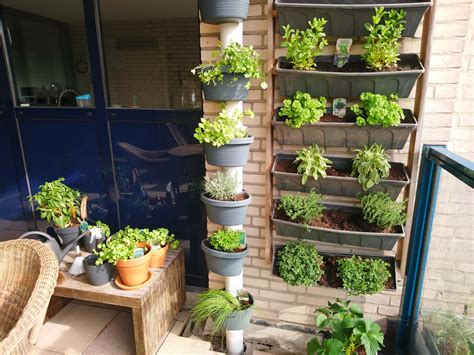5 Simple Steps to Create Your Own Balcony Herb Garden
Urban living doesn’t mean you have to give up on growing fresh herbs. With a bit of creativity and some careful planning, you can turn even the smallest balcony into a thriving herb garden. Not only does this enhance your outdoor space, but it also gives you fresh ingredients for your cooking while offering a sense of tranquility. Follow these five steps to easily create a balcony herb garden that fits your lifestyle and space.
Introduction
Herb gardens are practical, easy to care for, and incredibly rewarding. You don’t need a large backyard to grow your own fresh herbs. A small balcony can be the perfect spot, allowing you to nurture a variety of herb plants that will thrive in containers. In this guide, we’ll walk you through five simple steps to help you plan, plant, and maintain a thriving balcony herb garden, regardless of your gardening experience. Let’s get started!
Key Concepts
- Herbs: Plants that are used for flavoring, food, medicine, or fragrances. Examples include basil, mint, thyme, rosemary, and parsley.
- Container gardening: Growing plants in containers, rather than in the ground, which is ideal for small spaces such as balconies.
- Sunlight: Herbs generally need a lot of sunlight, so your balcony should receive at least 4-6 hours of sunlight per day.
- Watering: While herbs need regular watering, it’s essential to avoid waterlogging. Containers with good drainage are key.
- Care: Regular pruning and harvesting will promote growth and keep your herb garden productive.
Step 1: Plan Your Herb Garden Layout
The first step in creating your balcony herb garden is planning. Consider the space available and assess the amount of sunlight your balcony receives. Most herb plants require at least 4-6 hours of sunlight a day, so choose a sunny spot. If your balcony has limited sun, opt for herbs like mint and parsley that tolerate partial shade. Sketch out your space to determine how many containers you can fit comfortably.
| Herb | Light Requirements | Watering Needs | Notes |
|---|---|---|---|
| Basil | Full Sun | Regular | Pinch off the top leaves to encourage bushier growth. |
| Mint | Partial Shade | Moderate | Keep in a separate pot as it spreads quickly. |
| Thyme | Full Sun | Low | Does well in dry soil and requires little maintenance. |
| Rosemary | Full Sun | Low | Prefers dry conditions; avoid overwatering. |
| Parsley | Partial Shade | Regular | Great for garnishing dishes and requires frequent cutting. |
Step 2: Choose the Right Containers
Choosing the right containers is crucial for your herb garden’s success. Make sure the containers you use have good drainage to prevent root rot. While clay pots are visually appealing, they dry out more quickly than plastic containers, so consider your watering routine when selecting materials. You can also mix and match containers to add some variety to your balcony’s aesthetic. Herbs with extensive root systems like rosemary and sage may require deeper pots, while shallow-rooted herbs such as thyme can thrive in smaller containers.
- Use pots with drainage holes to avoid waterlogged soil.
- Consider the size of the pot based on the herb’s root structure.
- Use lightweight pots if your balcony can’t support much weight.
Step 3: Select the Right Herbs
When selecting herbs, think about the ones you use most frequently in your cooking. Basil, mint, rosemary, thyme, and parsley are common choices because they’re easy to grow and highly versatile. Consider combining herbs that have similar light and water requirements in the same pot. For example, rosemary and thyme both thrive in full sun and dry conditions, so they’re perfect companions.
Recommended Herbs for Balcony Gardens
- Basil – Great for Italian dishes, salads, and pesto.
- Mint – Ideal for teas, desserts, and cocktails.
- Rosemary – Excellent for roasted meats and vegetables.
- Thyme – Perfect for soups, stews, and marinades.
- Parsley – A must-have for garnishing and flavoring a wide variety of dishes.
Step 4: Plant and Care for Your Herbs
Once you’ve selected your herbs and containers, it’s time to plant them. Use a well-draining potting mix that retains moisture but doesn’t become waterlogged. Make sure to leave enough space between the plants so they have room to grow. Water the herbs immediately after planting to help them settle into their new environment. Remember, most herbs prefer slightly dry soil, so be careful not to overwater.
Herb Care Tips
- Water early in the day to allow the plants to absorb moisture before the sun is too strong.
- Prune regularly to promote new growth and prevent legginess.
- Rotate your pots occasionally to ensure all sides receive even sunlight.
- Fertilize with an organic herb-specific fertilizer once a month during the growing season.
Step 5: Harvesting and Maintenance
The final step is to maintain and harvest your herbs regularly. Frequent harvesting encourages most herbs to grow fuller and more robust. When harvesting, avoid cutting more than one-third of the plant at a time. Trim off flowers if they appear, as this directs the plant’s energy away from leaf production. Regular maintenance, including watering, pruning, and feeding, will keep your herb garden thriving.
Harvesting Tips
- For basil, pinch off leaves just above a pair of leaves to encourage bushier growth.
- For mint, cut the stems down to the base to stimulate regrowth.
- With rosemary, trim sprigs from the top without cutting into the woody part.
Case Studies
To illustrate how you can apply these steps, here are a few real-life examples:
| Location | Herb Selection | Challenges | Solution |
|---|---|---|---|
| City Apartment | Mint, Parsley, Basil | Limited Sunlight | Used a grow light to supplement natural light. |
| Suburban Balcony | Rosemary, Thyme, Oregano | Overwatering | Switched to containers with better drainage. |
| Urban Rooftop | Cilantro, Chives, Dill | Wind Exposure | Added windbreakers and positioned containers closer to the wall. |
Stakeholder Analysis
Gardening on a balcony may involve several stakeholders, including landlords, neighbors, and even local wildlife. Understanding their perspectives will help ensure your project runs smoothly.
- Landlords: Ensure that your herb garden doesn’t violate any building regulations, such as weight limits for balconies or water drainage issues.
- Neighbors: Be considerate of the plants’ spread and potential debris from containers or pots.
- Local Wildlife: Birds and insects may be attracted to your herbs, so plan for this by using covers or organic deterrents if necessary.
Implementation Guidelines
Creating and maintaining a balcony herb garden requires careful consideration of your environment. Here’s a quick implementation guide:
- Step 1: Assess the space and light conditions on your balcony.
- Step 2: Choose appropriate containers and herbs.
- Step 3: Plant and water correctly.
- Step 4: Maintain with regular pruning and rotation.
- Step 5: Harvest regularly to promote growth.
Ethical Considerations
As you set up your herb garden, it’s important to consider the ethical impact of your choices. Using organic materials, composting, and conserving water are all steps you can take to minimize your environmental footprint.
Limitations and Future Research
While a balcony herb garden is a great solution for urban dwellers, it has its limitations. Space constraints may prevent you from growing a wide variety of herbs, and weather conditions such as strong winds or limited sunlight could restrict your choices. Further research into vertical gardening techniques or smart gardening tools may offer solutions for maximizing small spaces and controlling environmental conditions.
Expert Commentary
Creating a balcony herb garden is not just a rewarding hobby, but it’s also a practical way to bring fresh herbs into your kitchen. Experts agree that balcony herb gardens are a low-maintenance, high-reward solution for urban dwellers looking to cultivate their own plants. With a thoughtful approach to layout, container selection, and herb care, anyone can enjoy the benefits of a fresh herb garden, no matter how small their outdoor space may be.


